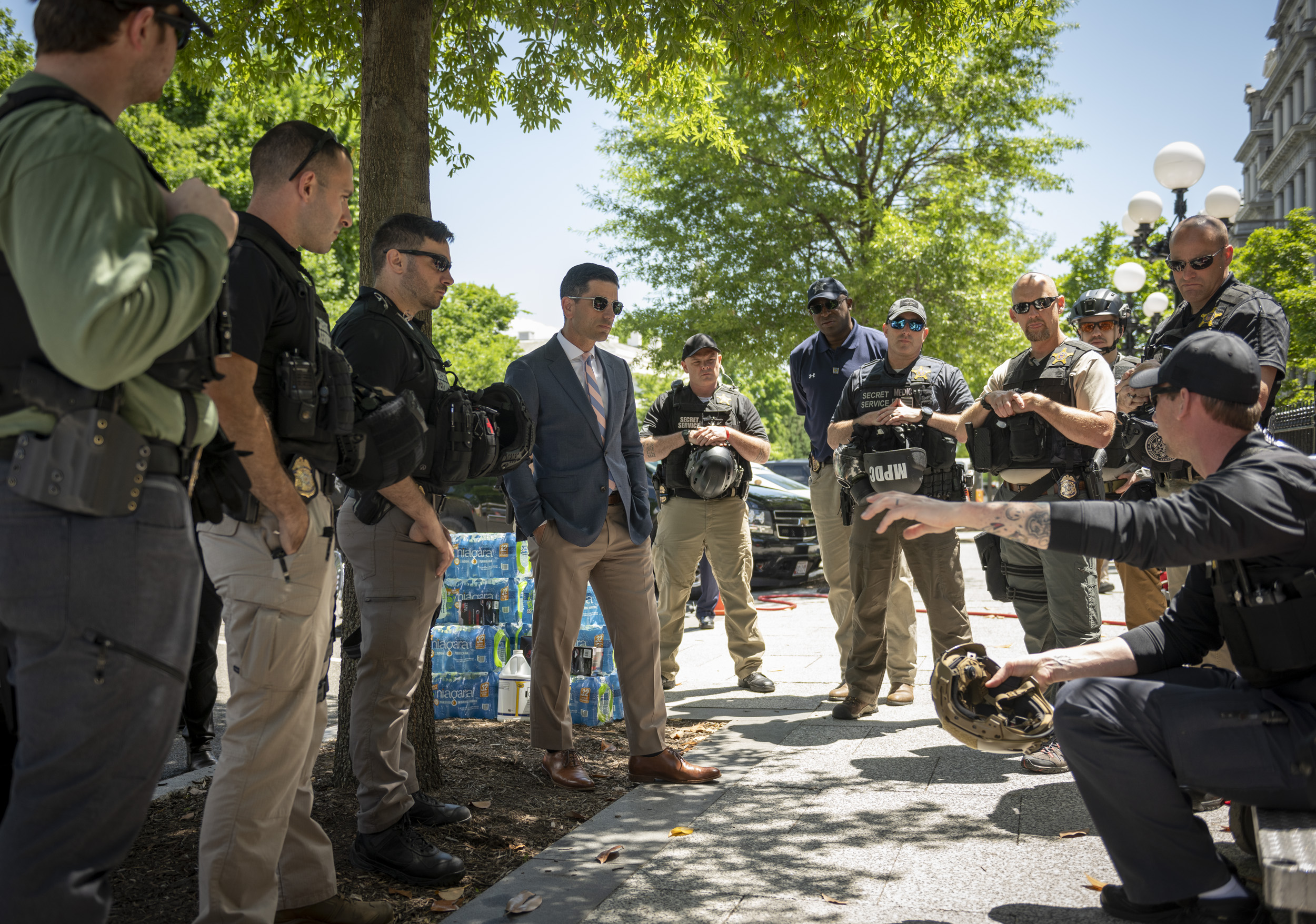DHS Authorizes Domestic Surveillance to Protect Statues and Monuments
A document provided to Lawfare indicates that the intelligence community is being tasked with monitoring and collecting information on some protest activities.

Published by The Lawfare Institute
in Cooperation With

You might not imagine that the U.S. intelligence community would have much stake in local protests over monuments and statues. You’d be wrong.
A document provided to Lawfare on July 19 from the Department of Homeland Security (DHS) Office of Intelligence & Analysis (I&A) describes personnel as “collecting and reporting on various activities in the context of elevated threats targeting monuments, memorials, and statues”—and it gives legal guidance concerning the “expanded intelligence activities necessary to mitigate the significant threat to homeland security” posed by such activities.
The document, titled “Job Aid: DHS Office of Intelligence & Analysis (I&A) Activities in Furtherance of Protecting American Monuments, Memorials, Statues, and Combatting Recent Criminal Violence,” is not classified. Its three pages each bear the heading “UNCLASSIFIED//FOR OFFICIAL USE ONLY.” But it clearly indicates that at least parts of the intelligence community are being tasked with monitoring and collecting information on some protest activities.
DHS official Ken Cuccinelli appeared to allude to this activity on CNN, stating of Portland, Oregon, “[W]e got intelligence about planned attacks on federal facilities .... If we get the same kind of intelligence in other places about threats to other facilities or officers, we would respond the same way.” But the memo makes clear that the authorized intelligence activity covers significantly more than just planned attacks on federal personnel or facilities. It appears to include planned vandalism of Confederate (and other historical) monuments and statues, whether federally owned or not. DHS did not respond to a voicemail and email seeking comment by the time of publication. We will add any comments or statements the department may release.
Here, we lay out what this document says and analyze what one can reasonably infer from it about ongoing intelligence collection with respect to the protests and the legal basis for such intelligence activities.
The DHS document offers legal guidance to its analysts regarding what is and is not appropriate collection and reporting with respect to a range of threats, including to monuments and statues, to federal personnel, to federal buildings and facilities, and to federal activities and programs. It is explicitly tied to President Trump’s executive order of June 26, which declared that “[i]t is the policy of the United States to prosecute to the fullest extent permitted under Federal law, and as appropriate, any person or any entity that destroys, damages, vandalizes, or desecrates a monument, memorial, or statue within the United States or otherwise vandalizes government property.” The order directed the attorney general to
work with State and local law enforcement authorities and Federal agencies to ensure the Federal Government appropriately provides information and assistance to State and local law enforcement authorities in connection with their investigations or prosecutions for the desecration of monuments, memorials, and statues, regardless of whether such structures are situated on Federal property.
And it directed “the Secretary of Homeland Security [to] provide ... personnel to assist with the protection of Federal monuments, memorials, statues, or property.”
At the time of its release, the executive order was widely mocked for not doing anything. After all, under a 2003 statute it was already a federal offense, punishable by up to 10 years in prison, to damage “any structure, plaque, statue, or other monument on public property commemorating the service of any person or persons in the armed forces of the United States.” Against that backdrop, the president’s protestations that he had effectively created a new crime rang more than a little hollow.
But at least DHS’s intelligence and analysis office appears to be interpreting the June executive order as defining a new homeland security priority—one that actually justifies intelligence collection. The memo opens:
This job aid supplements standing guidance on I&A’s conduct of intelligence activities and further informs personnel collecting and reporting on various activities in the context of elevated threats targeting monuments, memorials, and statues; law enforcement officers, facilities, and resources; and other government facilities. It is specific to expanded intelligence activities necessary to mitigate the significant threat to homeland security articulated in the President’s executive order of June 26, 2020.
I&A’s role, as one former head described it, is “to provide a comprehensive intelligence picture to DHS leadership, advocating for homeland requirements to the larger intelligence community, integrating information sharing and data analysis across DHS, partnering with non-federal members of the homeland security enterprise, and producing strategic intelligence in focused areas.”
The new memo, which is undated, is styled as specific implementation guidance with respect to the protests for more general rules regarding DHS intelligence activity. These rules authorize I&A intelligence activities on what are termed “departmental missions” where they assist in combating domestic terrorism threats; threats to critical infrastructure and key resources; significant threats to the economic security, public health or public safety; major disasters and other catastrophic acts; or “any other threat of such severity and magnitude that effective response would be beyond the capabilities of any affected State and local governments, such that Federal assistance would be necessary.” The rules also contain this catch-all sentence: “In addition, the intelligence activities of I&A personnel further a departmental mission where they support the Secretary, the Deputy Secretary, the DHS Chief of Staff, or their respective staff, Component Heads, or any other departmental officials, offices, or elements in the execution of their lawful missions.” In other words, if the president directs DHS and the rest of the government to protect monuments, then intelligence activity in support of monument protection is arguably furthering the departmental mission.
What kinds of collection and surveillance can DHS engage in for intelligence purposes generally? The rules spell out that:
I&A personnel are required to use the least intrusive collection techniques feasible and sufficient when collecting [U.S. person information] or when collecting intelligence or information within the United States. ... I&A personnel are permitted to engage in physical surveillance, the use of mail covers, and the use of monitoring devices only to the extent permitted by and consistent with [rules limiting their use to counterintelligence investigations]. I&A personnel are not permitted to engage in electronic surveillance or unconsented physical searches. Use of these techniques within the United States will be coordinated with the Federal Bureau of Investigation ….
So in other words, protesters can reasonably expect that there will be ongoing DHS collection and analysis of public source information about—and likely the social media postings of—people involved in protests.
The new memo adds some specific texture to the general rules in the context of the protests. It identifies three “appropriate missions” for I&A activities with respect to protest activity:
1. Threats to damage or destroy any public monument, memorial, or statue (MMS);
2. Threats of violence to law enforcement personnel, facilities, or resources; and
3. Threats to damage, destroy, or impede the functioning of other government facilities.
The latter two of these should be uncontroversial. To the extent there are serious threats to federal facilities or personnel, that’s obviously a homeland security subject that warrants reporting and analysis. Consequently, we focus here chiefly on the portion of the memo that deals with monuments and statues.
Indeed, the first of these missions is a bit jarring if you pause to think about it. We certainly did not anticipate when we read the executive order last month that the federal government would interpret it as defining the threat to deface monuments as a homeland security matter warranting domestic intelligence collection by the federal government against U.S. persons—even, say, a local public monument without a national profile. We suspect others did not anticipate that reading either.
To be fair, the memo makes clear that surveillance cannot take place “for the sole purpose of monitoring activities protected by the First Amendment or the lawful exercise of other Constitutional or legal rights, or for the purpose of suppressing or burdening criticism or dissent.” And it specifies—as do the more general rules—that officials need to have a “reasonable belief” that their activity supports one of the authorized missions. The memo states:
You establish reasonable belief as follows:
● By supporting your reasonable belief with facts and circumstances you can articulate.
● By not relying on “hunches” and intuitions, which are insufficient.
● By basing your reasonable belief on your own experience, training, and knowledge, while being able to state how you have applied your expertise to the facts before you.
But that still leaves an array of collection authorities available when an I&A analyst has a “reasonable belief” supportable with “facts and circumstances” that can be articulated of any “[t]hreats to damage or destroy any public monument, memorial, or statue.” That’s a pretty striking position for the federal government to be taking as a matter of both law and policy. Indeed, it’s difficult to understand the federal government’s interest in, or constitutional authority over, minor property damage to nonfederal monuments on nonfederal property.
What sort of information can be collected? “You may collect information about (i) threats to MMS, (ii) individuals or groups that pose such threats, or their tactics, techniques, or procedures (TTPs), and (iii) information that otherwise informs an overall assessment that threats to MMS will materialize.” The memo makes clear that “[p]ersons merely engaging in non-violent protest activities near MMS, or making hyperbolic statements about MMS likely do not constitute a threat to MMS” (emphasis added). Rather, it states, a “‘threat to MMS’ means the infliction of any damage sufficient to impede the purpose or function of the MMS.”
We will leave for another day the almost philosophical question of what level of damage might reasonably be said to impede the purpose or function of a statue. Suffice it to say that DHS analysts are now authorized to collect intelligence on threats to inflict such damage—though apparently not damage that falls short of impeding a statue’s “purpose or function,” whatever that may be.
The document also contains retention guidelines requiring that U.S. person information that does not further an appropriate mission “must be purged for operational purposes within 180 days of collection.” And it allows retained information to
be disseminated to another element of DHS, any federal, state, local tribal, or territorial government entity with law Enforcement (LE), counterterrorism (CT), or national or homeland security related functions or a private sector entity or individual with responsibilities relating to homeland security only where you have a reasonable belief that dissemination would assist that recipient in fulfilling one or more of its lawful intelligence, LE, CT, or other homeland security-related functions.
To be sure, nothing in the memo authorizes the federal government to take any coercive action against protesters in Portland—or anywhere else, for that matter. But the animating premise of the memo is that the threat to monuments and statues is a homeland security threat warranting intelligence analysis and collection by federal officials. To us, that premise is in equal parts unpersuasive and alarming. It is unpersuasive because it should be obvious that vandalism and other damage to monuments, even federal monuments, does not threaten the security of the homeland to any greater extent than most property crimes. We are unaware of prior memoranda that treat offenses against property as the basis for a homeland security investigation—even when the property at issue is federal property.
The premise is alarming because it uses the cover of minor property damage, whether to federal property or otherwise, to justify intelligence gathering against ordinary Americans—most of whom have nothing to do with the underlying property damage, and many of whom are engaged in the most American of activities: peacefully protesting their government.
Of course, if there are groups plotting more serious violence, we wouldn’t dispute for a second that such plotting is appropriately within the purview of I&A and other federal intelligence components—or that existing authorities allow the federal government to act aggressively to preempt and deter such criminal conduct. But we do not accept that graffiti and vandalism are remotely comparable threats to the homeland—or that they justify this kind of federal response even if, in the right circumstances, such activity would technically constitute a federal crime. A memo like this leaves the unfortunate impression that, once again, the White House and the Department of Homeland Security are using disagreements over monuments as an opportunity to send a much larger message—in this case, that the current administration sees dissent itself as a threat to homeland security.




.png?sfvrsn=48e6afb0_5)

